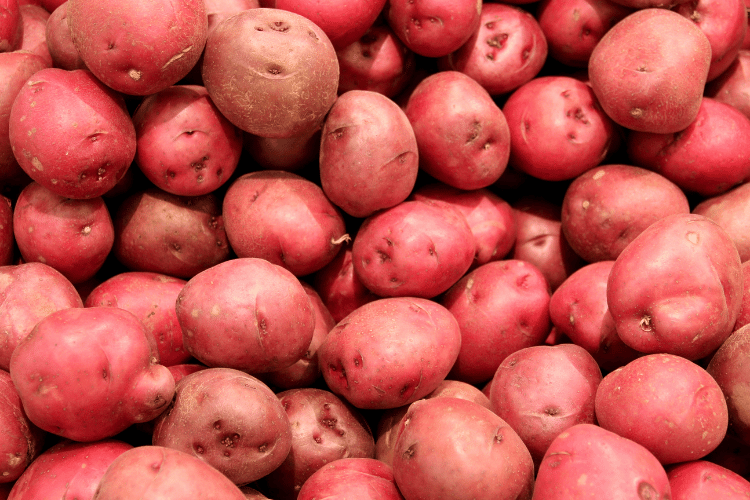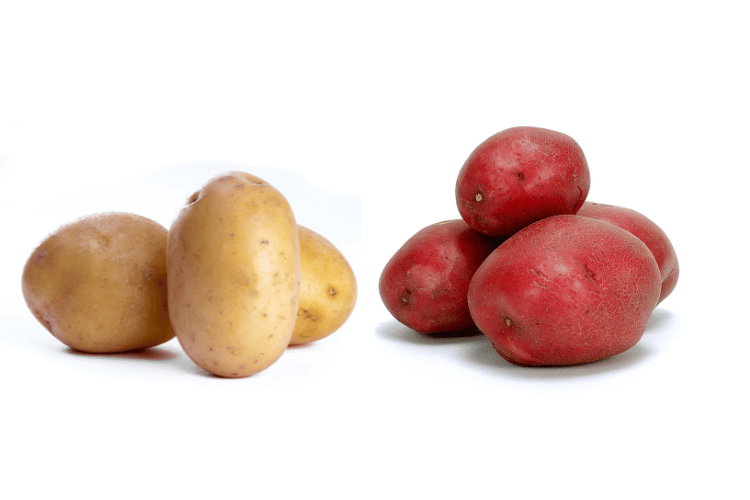When it comes to eye-catching potato varieties, the red-skinned ones definitely come to mind. Thanks to their vibrant colors, those starchy vegetables can add a delightful pop to any dish.
One question that may arise when shopping for these tuber varieties is: are red potatoes naturally red?
That’s what we’ll explore in this article. From the reason behind the red skin color to the health benefits, keep reading for all the details!

Are Red Potatoes Naturally Red?
Yes! Red potatoes are naturally red. That striking color is due to anthocyanins, a plant pigment responsible for blue, red, or purple colors.
Aside from providing visually appealing shades to fruits, vegetables, and flowers, anthocyanins pose numerous health benefits.
Those pigments have anti-inflammatory and anti-cancer properties thanks to their antioxidant activity.
You see, UV rays and other electromagnetic radiation can damage cell components and produce reactive oxygen species (ROS).
Those molecules contain oxygen with an extra electron, making them unstable. To overcome that issue, they react with tissue components, like DNA, RNA, proteins, and more, causing cell death.
Antioxidants, like anthocyanins, scavenge ROS, reducing oxidative damage to your tissues.
Are Red Potatoes Dyed?
As mentioned earlier, red-skinned potatoes naturally possess this color. However, that doesn’t mean they don’t have any color additives.
Plants produce anthocyanins as a response to stressors, such as unfavorable temperatures, light, and infections.
The pigment amount depends on various environmental factors, particularly light. Like melanin in humans, the former chemical absorbs excess radiation, protecting the leaves from damage.
However, those colorful molecules can only handle sunlight to a certain extent. Prolonged radiation exposure destroys anthocyanins. As a result, the vibrant red color of this potato variety fades away. Unless you notice visible bruising, pungent smells, or other deformities, nothing is wrong with those tubers, and you can still eat them.
Unfortunately, some sellers can use artificial red dyes to add a bit of color and keep the potatoes vibrant. Such artificial additives have been linked to various health hazards. Luckily, washing the vegetables will help you tell whether or not they’re dyed.
Red Potatoes vs. White Potatoes: What Are the Differences?

Now that you know red-skinned potatoes are natural, let’s compare them with another popular potato variety, the white-skinned tubers.
Appearance
At first glance, you can tell that red and white potatoes have different colors. The former can vary from dark red or ruby hues to light pink shades. They also have darker flesh that ranges from creamy white to golden yellow.
As for the white variety, it can have white, light beige, or slightly tan skin and white flesh. However, don’t mistake them for russet potatoes. The latter have dark brown skin and are generally larger.
Aside from the color, red potatoes typically have thinner skin than white potatoes. That can be convenient because you can skip the peeling and directly cook those round tubers.
Texture and Flavor
Sure, all potatoes are starchy vegetables that grow underground, but that doesn’t mean they’re equal. Believe it or not, those fleshy tubers can vary in flavor and texture.
Red potatoes have a smooth, waxy texture when boiled. They also taste a bit sweeter and richer. A part of that has to do with its high sugar content.
White potatoes, on the other hand, have a creamy, slightly dense texture due to their high starch content. They’re also subtly sweet since starch breaks down into sugars during cooking.
As you can see, both tubers have different physical properties once cooked, which you can use to make a variety of dishes. And that brings us to the next comparison point: culinary uses!
Culinary Uses
Potatoes are one of the most versatile vegetables. You can use them to make delicious roasts, stews, soaps, dumplings, pancakes, healthy side dishes, and more.
To take your recipes to the next level, make sure to pick the right potato variety. Thanks to their waxy texture, red potatoes hold together when cooked. You can use that in any recipe that requires shape and firmness.
For instance, you can boil red-skinned potato cubes and add some herbs as well as a mayo dressing to make a creamy potato salad. They’ll also make a great addition to any chicken crockpot recipe.
The white variety, on the other hand, is excellent for making a creamy mashed potato dish. As you might have guessed, the high starch content is behind that heavenly texture. It absorbs the butter and milk while holding the mix together.
White potatoes also make superb French fries. Unlike red-skinned tubers, the former doesn’t have a high sugar content. Why is that a problem? Well, because sugar caramelizes once deep fried, resulting in a bitter, burnt taste.
Health Benefits
Contrary to popular belief, potatoes are healthy. Those high carbohydrate-containing foods are packed with many nutrients. That includes vitamin B6 and vitamin C, both of which are important for metabolism and provide antioxidant activity.
They also contain dietary fibers, which are important for your digestive health. Potato skin is a source of potassium and magnesium. Those minerals help keep the blood pressure in check.
Generally, red potatoes have fewer calories than white potatoes. They also contain more vitamins and antioxidants. However, the difference isn’t that significant; they’re almost identical.
Glycemic Index

For those who don’t know, the glycemic index (GI) is a system that rates carbohydrate-rich foods based on their ability to spike blood glucose.
Foods with a lower GI take a longer time to metabolize. Consequently, they don’t change your blood glucose level. That can make you feel full for a prolonged period, helping you lose weight.
That’s not to say foods with a higher GI are unhealthy. For example, sweet fruits like watermelons contain a high sugar content, but they’re also packed with nutrients.
The GI system is simply a tool to help control your blood glucose, which is crucial for diabetic patients.
Generally, waxy potatoes, like the red-skinned variety, have a lower GI than starchy types. So, if you’re someone with diabetes, consider substituting white potatoes for red tubers.
Wrapping Up
So, are red potatoes naturally red?
Red potatoes are naturally red due to the plant pigment anthocyanins. Potatoes produce those chemicals as a stress response to many environmental conditions, like light. Unlike dyed potatoes, the natural red color won’t fade away from the skin when you wash the potatoes.
Compared to common potato types, like white-skinned tubers, this colorful variety has a waxy texture, a slightly sweet flavor, and a lower glycemic index. Both varieties offer numerous nutritional benefits, with red potatoes being slightly higher in vitamins and antioxidants.
Still, regardless of the potato variety, those tubers are packed with essential nutrients, making them a fantastic addition to your diet!
- How To Fill a King Cake With Bavarian Cream - April 15, 2024
- Dealing With Mold on Oyster Mushrooms - April 9, 2024
- What Meat Goes With Pumpkin Ravioli? (Ravishing Ravioli Combos) - March 15, 2024
